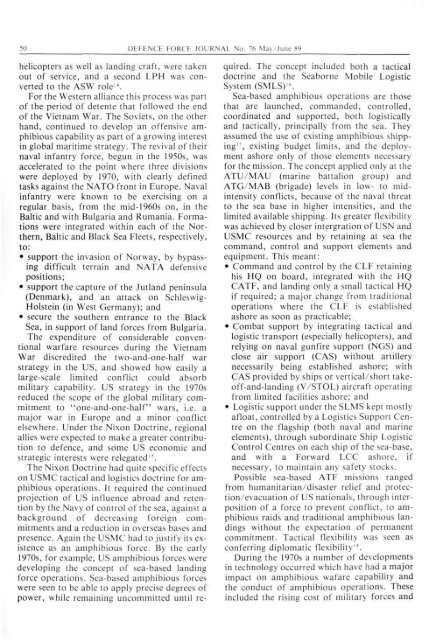ISSUE 76 : May/Jun - 1989 - Australian Defence Force Journal
ISSUE 76 : May/Jun - 1989 - Australian Defence Force Journal
ISSUE 76 : May/Jun - 1989 - Australian Defence Force Journal
- No tags were found...
Create successful ePaper yourself
Turn your PDF publications into a flip-book with our unique Google optimized e-Paper software.
50 DEFENCE FORCE JOURNAL No. <strong>76</strong> <strong>May</strong>/<strong>Jun</strong>e 89helicopters as well as landing craft, were takenout of service, and a second LPH was convertedto the ASW role 14 .For the Western alliance this process was partof the period of detente that followed the endof the Vietnam War. The Soviets, on the otherhand, continued to develop an offensive amphibiouscapability as part of a growing interestin global maritime strategy. The revival of theirnaval infantry force, begun in the 1950s, wasaccelerated to the point where three divisionswere deployed by 1970, with clearly definedtasks against the NATO front in Europe. Navalinfantry were known to be exercising on aregular basis, from the mid-1960s on, in theBaltic and with Bulgaria and Rumania. Formationswere integrated within each of the Northern,Baltic and Black Sea Fleets, respectively,to:• support the invasion of Norway, by bypassingdifficult terrain and NATA defensivepositions;• support the capture of the Jutland peninsula(Denmark), and an attack on Schleswig-Holstein (in West Germany); and• secure the southern entrance to the BlackSea, in support of land forces from Bulgaria.The expenditure of considerable conventionalwarfare resources during the VietnamWar discredited the two-and-one-half warstrategy in the US, and showed how easily alarge-scale limited conflict could absorbmilitary capability. US strategy in the 1970sreduced the scope of the global military commitmentto "one-and-one-half" wars, i.e. amajor war in Europe and a minor conflictelsewhere. Under the Nixon Doctrine, regionalallies were expected to make a greater contributionto defence, and some US economic andstrategic interests were relegated' 5 .The Nixon Doctrine had quite specific effectson USMC tactical and logistics doctrine for amphibiousoperations. It required the continuedprojection of US influence abroad and retentionby the Navy of control of the sea, against abackground of decreasing foreign commitmentsand a reduction in overseas bases andpresence. Again the USMC had to justify its existenceas an amphibious force. By the early1970s, for example, US amphibious forces weredeveloping the concept of sea-based landingforce operations. Sea-based amphibious forceswere seen to be able to apply precise degrees ofpower, while remaining uncommitted until required.The concept included both a tacticaldoctrine and the Seaborne Mobile LoeisticSystem (SMLS)' 6 .Sea-based amphibious operations are thosethat are launched, commanded, controlled,coordinated and supported, both logisticallyand tactically, principally from the sea. Theyassumed the use of existing amphibious shipping1 ", existing budget limits, and the deploymentashore only of those elements necessaryfor the mission. The concept applied only at theATU/MAU (marine battalion group) andATG/MAB (brigade) levels in low- to midintensityconflicts, because of the naval threatto the sea base in higher intensities, and thelimited available shipping. Its greater flexibilitywas achieved by closer intergration of USN andUSMC resources and by retaining at sea thecommand, control and support elements andequipment. This meant:• Command and control by the CLF retaininghis HQ on board, integrated with the HQCATF, and landing only a small tactical HQif required; a major change from traditionaloperations where the CLF is establishedashore as soon as practicable;• Combat support by integrating tactical andlogistic transport (especially helicopters), andrelying on naval gunfire support (NGS) andclose air support (CAS) without artillerynecessarily being established ashore; withCAS provided by ships or vertical/short takeoff-and-landing(V/STOL) aircraft operatingfrom limited facilities ashore; and• Logistic support under the SLMS kept mostlyafloat, controlled by a Logistics Support Centreon the flagship (both naval and marineelements), through subordinate Ship LogisticControl Centres on each ship of the sea-base,and with a Forward LCC ashore, ifnecessary, to maintain any safety stocks.Possible sea-based ATF missions rangedfrom humanitarian/disaster relief and protection/evacuationof US nationals, through interpositionof a force to prevent conflict, to amphibiousraids and traditional amphibious Iandingswithout the expectation of permanentcommitment. Tactical flexibility was seen asconferring diplomatic flexibility".During the 1970s a number of developmentsin technology occurred which have had a majorimpact on amphibious wafare capability andthe conduct of amphibious operations. Theseincluded the rising cost of military forces and
















